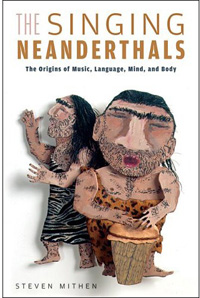
 Did you ever stop and wonder, “Where the hell did music come from?”
Did you ever stop and wonder, “Where the hell did music come from?”
The public has many misconceptions about how music began. Perhaps the biggest of all is that music had its origin as entertainment — a superfluous if enjoyable pastime.
It is easy to see where we might have gotten this idea. For decades the culture industry ensured that music’s primary role in our society was as entertainment. They were strongly motivated to do so mostly because this made recordings eminently more consumable and profitable for the corporations that exploited music’s creators and producers.
Entertainment is surely one of the purposes of music. To be fair, most people do realize it’s not the only purpose. Live performances can and have united broad swaths of society in ways that transcend simple amusement. Music can be used as therapy or as a call to action. Songs can move us to tears or lift our spirits far beyond a simple diversion. The right song played at the right time is not just a part of one’s music library, but a part of one’s soul. And it would be hard to argue the entertainment value of the funeral dirge or the sonic torture of Iraqi prisoners of war. Clearly, there is something more to music than mere entertainment.
Most of us don’t need empirical evidence to prove the power of music extends beyond entertainment — this fact is intuitive. But it turns out that we had very few facts about the origin of music until quite recently. Only in the last few years that the fields of neurology, cognitive science, psychology, sociology, anthropology and linguistics overlapped in some pretty remarkable patterns. In the process, academia is beginning to reveal the true nature of the origin of music. Humans can now grasp the meaning of music in ways that were inaccessible for millions of years.
Though a mountain of academic research has built up over the past few years, a trio of layman’s nonfiction books brilliantly lay out the three key pieces of the origin of music puzzle.
 Steven Mithin’s The Singing Neanderthals: The Origin of Language, Mind and Body blew the topic wide open in 2005. The eminent archaeologist revealed music as a precursor and shaping force of language, imbuing it with the emotional meaning that pure semantics could not evoke. His ‘Hmmmm’ theory describes primitive verbalization as a combination of holistic, manipulative, multi-modal, musical and mimetic functions. Essentially, our system of communication was formed by representing nature with the sounds we could make (in addition to, and inseparable from parallel evolutions in gesture and bodily expression).
Steven Mithin’s The Singing Neanderthals: The Origin of Language, Mind and Body blew the topic wide open in 2005. The eminent archaeologist revealed music as a precursor and shaping force of language, imbuing it with the emotional meaning that pure semantics could not evoke. His ‘Hmmmm’ theory describes primitive verbalization as a combination of holistic, manipulative, multi-modal, musical and mimetic functions. Essentially, our system of communication was formed by representing nature with the sounds we could make (in addition to, and inseparable from parallel evolutions in gesture and bodily expression).
Over time, this communication system not only evolved along with the growing sophistication of our brains, but was directly responsible for said evolution. Evolutionary changes to our vocal tract and bipedal capacity for rhythmic movement helped amplify and articulate interpersonal interaction within primitive human societies. The result was that music functioned to unify primitive humans by providing ways for them to evoke emotion and meaning in each other with vocalizations and body movement.
 Since Mithin’s book was published in 2005, one might say that more happened in the interdisciplinary study of the origin and meaning of music than in all years previous. Much of this work was highly academic and analytical. Then last year another breakthrough theory of the origin of music hit the scene of layman nonfiction. Mark Changizi’s Harnessed: How Language Mimicked Nature and Transformed Ape to Man followed the wave of evidence suggesting that the high-level functions of our brain (for example, appreciating a symphony) were emergent from lower-level functions that had evolved over millions of years by miming nature as a form of interpersonal communication. In other words, our brains were not “mind over matter” so much as “mind from matter”.
Since Mithin’s book was published in 2005, one might say that more happened in the interdisciplinary study of the origin and meaning of music than in all years previous. Much of this work was highly academic and analytical. Then last year another breakthrough theory of the origin of music hit the scene of layman nonfiction. Mark Changizi’s Harnessed: How Language Mimicked Nature and Transformed Ape to Man followed the wave of evidence suggesting that the high-level functions of our brain (for example, appreciating a symphony) were emergent from lower-level functions that had evolved over millions of years by miming nature as a form of interpersonal communication. In other words, our brains were not “mind over matter” so much as “mind from matter”.
Changizi’s book makes a lucid, elegant case for a simple hypothesis: “music sounds like humans moving and behaving (usually expressively)” or in other words, “music moves us because it literally sounds like moving.” Harnessed details how virtually every major facet of music has a counterpart in the sound generated from the movement of our bodies and other physical objects in space. This is particularly true when it comes to interactions with other humans and our ability to perceive mood, intent, proximity and a host of other important sensory cues from the sound of their movement, whether or not they were paired with visual cues.
In nature, most visual stimuli are stationary and when movement does occur there is no guarantee it will be in view, but nearly every movement event makes a sound. Furthermore, each event has a sound signature that we have evolved to detect intuitively, down to the microtonal nuance.
Audition is important because at any given time, objects and events in eyeshot are only a fraction of what is in earshot. Our primitive ancestors would have been highly attuned to the sounds around them, and used sound and gesture to mimic environmental sensory input to communicate elemental concepts and feelings to their brothers and sisters. Music’s meaning to primitive humans was that of unification and interaction, so they could help each other survive. Of course this does not preclude the idea that some primitive musical communication was also meant purely to evoke pathos or joy, absent any deeper representative meaning — in other words, the first signs of music as entertainment.
When Changizi proudly proclaims in his book that ‘Soylent Music’ is made out of people, he means that musical sound is literally derived from the four elemental parameters of the movement of an individual in relation to another human. To paraphrase, he classifies these parameters as (1) proximity, (2) direction, (3) speed and (4) gait. They share a respective relationship with the four elemental parameters of music: (1) loudness, (2) pitch (and specifically, the Doppler effect), (3) tempo and (4) beat/rhythm. Without reading the text this may all sound quite abstract, but when the concept sinks it can profoundly alter one’s understanding of what music is on the most fundamental level.
To provide a quick example before wrapping up, consider the ubiquitous pop song. Like fast food or nicotine, pop music is highly consumable because it stokes our brains with pleasure chemicals and makes our brains beg for more.
Taking the parameters above, we see that pop music’s proximity/loudness mimics intimacy and leaves the listener feeling as if the singer is within arm’s reach. The direction/pitch of pop hooks rises and falls in a way that mimics the subtle movements (and subsequent sounds) of two bodies interacting in significant social rituals. The speed/tempo of these songs is almost always mid- or up-tempo, specifically calibrated to make you want to move your body. Finally the, gait/rhythm literally represents the ‘shuffle’ of our body parts as we move through space. The highly syncopated rhythms of popular music are analogous to movement that would be screaming for our attention. In fact, the whole package is designed not only to scream for our body’s attention, but to create a series of expectations and resolutions using the metaphor of movement. Though this is not exactly what cognitive scientist Steven Pinker was talking about when he controversially called music “auditory cheesecake”, a more apt description for pop music is hard to come by — it is engineered to tickle all our most pleasurable deep-seated movement instincts.
 The last book in the origin of music trio helps to put Mithin’s and Changizi’s work into perspective. Bernie Krause’s The Great Animal Orchestra: Finding the Origins of Music in the World’s Wild Places is half-layman’s science nonfiction, half memoir of his world travels as recorder of soundscapes. In one of the coolest jobs on the planet, Krause traversed the globe and recorded all manner of sound, natural and unnatural.
The last book in the origin of music trio helps to put Mithin’s and Changizi’s work into perspective. Bernie Krause’s The Great Animal Orchestra: Finding the Origins of Music in the World’s Wild Places is half-layman’s science nonfiction, half memoir of his world travels as recorder of soundscapes. In one of the coolest jobs on the planet, Krause traversed the globe and recorded all manner of sound, natural and unnatural.
The author breaks these sound sources into three types: “(1) nonbiological natural sounds — the geophony; (2) sounds originating from nonhuman, nondomestic biological sources — the biophony; and (3) human-generated sound — anthrophony — where it intrudes and, in a few cases, blends.”
The previous authors rightly focus on the third type of sound as ground zero for the emergence of music and language. Krause puts it all back in perspective by contrasting our noisy, human-dominated modern soundscapes with the natural sound tableaus that served as the inspiration for our audition adaptations. If we listen closely, we can hear nature — the original source of our inspiration — being drowned out by the noise of modernity.
Krause’s rumination on how the soundscape of our lives has changed from one that was directly in tune with nature to one that blares dissonantly and incessantly in our ears does not break the same theoretical ground the first two books do. What it does do is humanize the science behind the origin of music. As a culture and society, we would all do well to learn from the way music began, if only to help contrast today’s entertainment-dominated music industry with music’s more deeply meaningful roots as a unifying force. Perhaps then musicians and listeners can start to take steps to reclaim music’s power from market forces.
